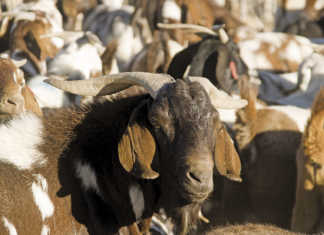

One of the many important things to keep track of when raising goats is their body condition. Just like every other species of animal including us as humans, goats are better off achieving and maintaining an ideal weight. Being either underweight or overweight can be problematic, so being able to determine your goats’ true body condition goes a long way towards weight monitoring and maintenance.
In order to start body condition scoring your goats, you first need to know what to look for as well as where to look. Most scoring is done by examining the loin and making a determination based on what can be felt. The loin of a goat is located on the back between the ribs and hips in an area that is much like what a waist would be for human comparison. When you locate this area, feel it with your hands. What you feel should correspond with one of the body condition score below.
The first body score that could be assessed is a poor condition. A goat that falls into this category will have a concave appearance in which bones can be easily felt with little to no muscle or fat present to pad the area. Spinal bones will be prominent and the area may appear hollow.
Next is a body score that is considered thin. In this case, there will be some muscle and less of a concave, hollow appearance. Though there is some padding, it will still be possible to feel spinal bones, but they will be less prominent than on a goat in poor condition.
Goats are considered to be in an Ideal /good condition when they have adequate muscle to cover most of the spinal bones while at the same time allowing for them to be felt when light pressure is applied. Though fat is present, it is not excessive, creating smooth lines between the spine and hips but still allowing them to be visually distinct.
While other goats are considered fat, it is important to remember that no more muscle growth is possible. At this point, any increase in goat flesh is just that: fat. In order to feel the spine and hip bones of a fat goat, firm pressure is needed. Visual inspection will yield a rounded appearance thick with padding between the spine and hips.
Obese goats, under this condition it will not be possible to feel bones as they will be too encompassed by fat. Instead of appearing round, a bulge is created by excess fat and a dip is created where the spine is located, almost giving the goat the appearance of a human rump.
When it comes to goat weight, it is important to achieve a happy medium, such as with an Ideal or good body score . Anything less than that indicates that a nutritional void is present, which can be caused by a number of things including inadequate diet, parasites, or disease. Goats that are underweight while exposed to a buck may abort and if they do carry to term, may give birth to stunted offspring which fail to thrive. Oppositely, goats that are fat or obese can have their own set of problems related to excessive feeding and too little exercise among other things. These goats may then fall victim to dystocia, joint problems, infertility, and a lack of stamina, but or develop metabolic disease can affect goats that are either underweight or overweight.
In order to keep your goats at a weight that is ideal for them, monitoring diet and exercise is necessary. Just like us, some goats may gain or lose weight more easily than others and need to be fed accordingly. Even then there are variables that must be considered, especially when it comes to pregnant does which can benefit from a little bit of additional weight as they go into milk. Sometimes achieving this ideal balance will involve some trial and error, but the sooner you begin an attempt to achieve it, the better off your goats will be.
 Contact Jaguza Support
Contact Jaguza Support